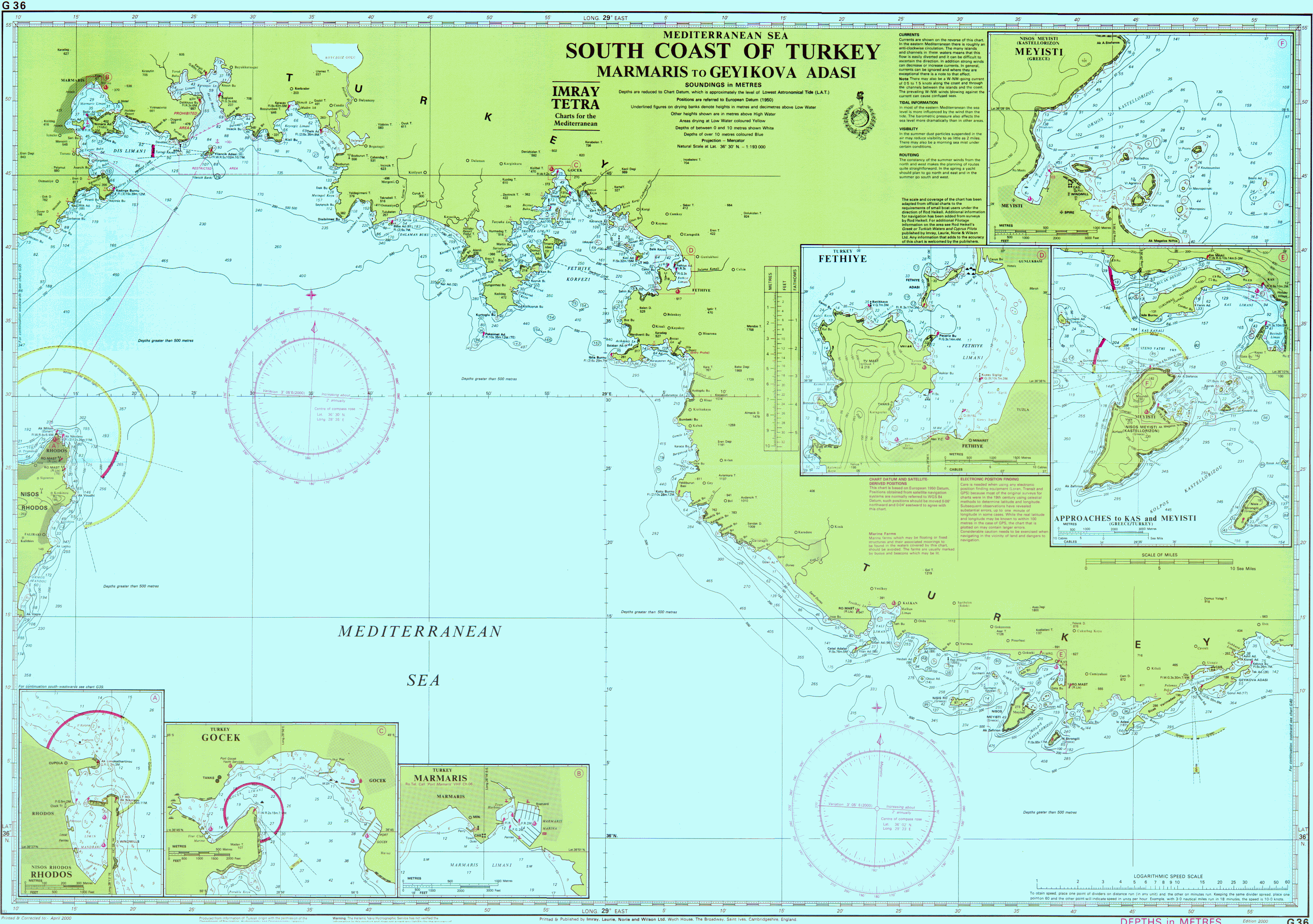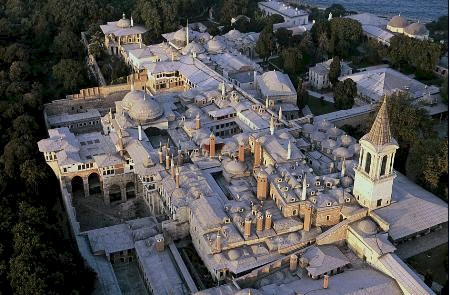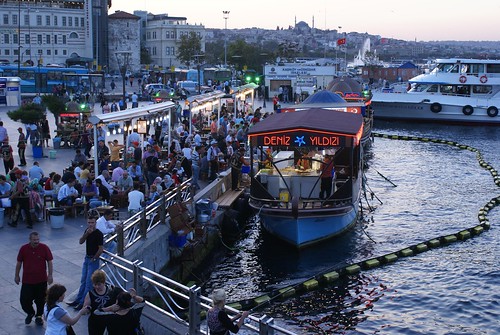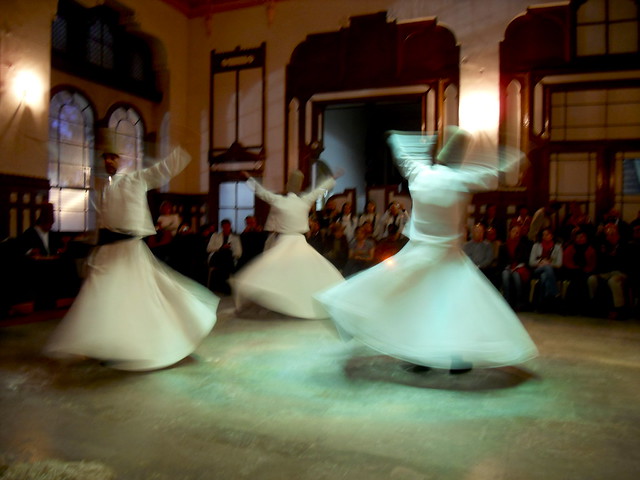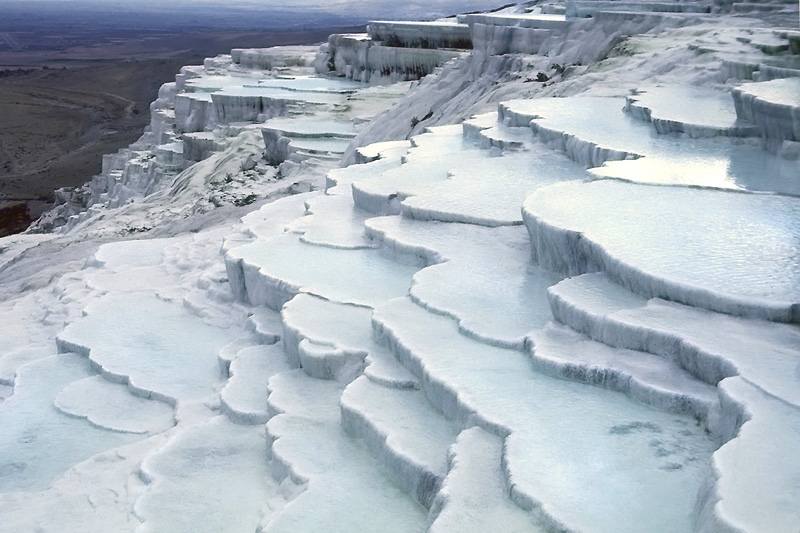View Turkey in a larger map
COMPLETED ITINERARY
SAT 8/25
5:40am Arrived at
IST; train to Gülhane station; dropped off bags
8am Blue Mosque;
9am Basilica Cistern; 10am Hagia Sophia
12pm Karakoy,
Galata Bridge
1pm Checked into
Modern Sultan
5pm Grand Bazaar;
Spice market; Dinner at Alemdar
SUN 8/26
6am Van
to S. Gokcen airport (SAW); 8:40am SAW–ASR
12:30pm checked
into Kelebek without correct reservation date
6:30pm Rose
Valley sunset; Dinner at Kelebek
MON 8/27
10am Kaymakli;
12pm Derinkuyu Underground Cities
1pm Checked in
next door at Sultan Cave Suites
4:30pm Goreme
Open Air Museum; Dinner at Sultan
TUE 8/28
1pm Drove around;
3pm Zelve Open Air Museum
4:30pm Drove to
Kayseri airport; 7:20pm ASR–DLM
11:20pm Arrived
DLM; Drove to Dalyan; Caria Hotel
WED 8/29
5am–8:30am Drove
to Ephesus
12pm Drove
Parisian hitchhikers to Selçuk
2pm Pamukkale,
checked into Melrose House Hotel
5pm Hiked up
travertine; Hierapolis/ Cleopatra's pool
7pm Hiked back
down; Dinner at Melrose
THU 8/30
11am–2pm Drove to
Saklikent
2pm-5pm Hiked
Gorge to waterfalls and back
6pm Drove south
to Kaş; 7:30pm Checked into Kayahan
9pm Dinner at Sumanu Sarap Evi; Late walk/shopping
FRI 8/31
10am-1pm Cinarlar
Beach; 2pm Drove to Demre
3pm–5:30pm Drove
to Çirali; Olympos Ruins
8pm Hiked mile up
to the Chimera flames
9pm-12pm Drove
back to Kaş
SAT 9/1
12am-3pm Drove
to Goçek (Marinturk Marina); Peitho
6pm DLM met up
with Tom, Sandy; 7pm Van pick-up
9pm Grocery
shopping; Dinner at Kebab Hospital
SUN 9/2
11am-5pm Sailed
to Oludeniz; Sandy got boat-sick for 4-hrs
9:30pm Finally
found Nolan at Jade Residence (was at Terrace)
10:30pm Boat taxi
back to Peitho, anchored overnight
MON 9/3
9:30am Met Tom at
the beach with the dinghy
1pm Bus to
Fethiye w/Sandy
10am-2pm Lu, Tom,
Nolan sailed
3pm Moored at Ece
Saray Marina in Fethiye
4pm Late lunch at
Kum Saati bar
9pm Dinner at
Reis
TUE 9/4
11am Walked into
town looking for camera repair/glasses repair
2pm Motored to
Kuçuk Samanlik beach; 6pm Return to Fethiye
9pm Dinner at the
Duck Pond
WED 9/5
12:30pm Sailed
across bay
4pm Early Dinner
at Göblún
6:30pm Anchored
at Cleopatra’s Bath; night swimming
THU 9/6
11am Swam to
Cleopatra’s Bath Ruins
1pm-2:30pm Sailed
back to Goçek
4pm Late Lunch at
Kebab Hospital; Napped; 10pm Late walk
FRI 9/7
10am Tour to
Dalyan; boat-ride to Mud Baths;
2pm Lunch at
Other Side; 4pm Iztuzu Beach
7pm Goçek refuel;
9pm Dinner at Goçek Pide
SAT 9/8
8am Van to DLM;
9am Nolan caught earlier flight
9:55am Sandy Tom
flight; 10:55am DLM–SAW, shared taxi
2pm Finally found
Nolan and checked into Home Suite Galata
3pm Lunch at Kiva
Han; Metro from Karakoy to Beyazit
5:30pm Grand
Bazaar; Sultanahmet
9pm Pide and
beers next to Galata tower
SUN 9/9
7:25am IST flight
home with the PNS crew
GENERAL INFO
Boston-----------7hrs-----------Istanbul
VISAS: Americans pay $20 before going through passport control at the airport/bus/trains. Buying a visa at a Turkish consulate before you travel will cost you more
- mainlaind- conservative dress, covered shoulders, NO SHORTS men/women
- in mosques- light head scarf, socks, back to carry shoes, leggings to wear under a dress to cover knees
- in mosques- light head scarf, socks, back to carry shoes, leggings to wear under a dress to cover knees
- public tuvalets are squat, 1TL; Mosque bathrooms are free
- tips are change/round up/ 10%
Sailing Info
Lying/Heaving/Anchoring
Gocek
Fethiye
Oludeniz
Kalkan
Kas
Kekova approach (shallow reefs, gusts)
byo towels, headlamp, food/drinks, snorkel gear, bug spray, sunblock etc
Airport transfers
- Taxi IST to Sultanahment - 35TRY/ $22
Sailing Info
Lying/Heaving/Anchoring
Gocek
Fethiye
Oludeniz
Kalkan
Kas
Kekova approach (shallow reefs, gusts)
byo towels, headlamp, food/drinks, snorkel gear, bug spray, sunblock etc
Airport transfers
- Taxi IST to Sultanahment - 35TRY/ $22
- Prebook Van Sultanahmet to SAW - €10pp
http://www.istanbulairportshuttle.com 6am Sultanahment to SAW
or Taxi is 85TRY/ $50
or Bus is 12TRY/$8 http://www.havatas.com/en/coach.aspx?i=2
- Taxi DLM to Gocek - 75TRY/ $50 or Havas?
- Taxi SAW to Taksim - 75TRY/ $40
or bus for 7TRY pp http://www.sabihagokcen.aero/havatas_shuttle (every 30min)
- Taxi Taksim to IST - 45TRY/ $25
http://www.istanbulairportshuttle.com 6am Sultanahment to SAW
or Taxi is 85TRY/ $50
or Bus is 12TRY/$8 http://www.havatas.com/en/coach.aspx?i=2
- Taxi DLM to Gocek - 75TRY/ $50 or Havas?
- Taxi SAW to Taksim - 75TRY/ $40
or bus for 7TRY pp http://www.sabihagokcen.aero/havatas_shuttle (every 30min)
- Taxi Taksim to IST - 45TRY/ $25
ISTANBUL
Sultanahmet
The Blue Mosque (Called Sultanahmet Camii in Turkish) is an historical mosque in Istanbul. The mosque is known as the Blue Mosque because of blue tiles surrounding the walls of interior design.Mosque was built between 1609 and 1616 years, during the rule of Ahmed I. just like many other mosques, it also comprises a tomb of the founder, a madrasa and a hospice. Best way to see great architecture of the Blue Mosque is to approach it from the Hippodrome. (West side of the mosque) As if you are non-Muslim visitor, you also have to use same direction to enter the Mosque.
Closed during call to prayer times:
1) Imsak / Fajr - Two hours before dawn
2) Güneş /Tulu - Dawn
3) Ögle / Zuhr - Midday
4) Ikindi / Asr - Afternoon
5) Aksam / Maghrib - Sunset
6) Yatsi / Isha - Right before last light of the day get disappeared
Aya Sofya/ Hagia Sophia
The church of Hagia Sophia (literally "Holy Wisdom") in Constantinople, now Istanbul, was first dedicated in 360 by Emperor Constantius, son of the city's founder, Emperor Constantine. Hagia Sophia served as the cathedra, or bishop's seat, of the city. Originally called Megale Ekklesia (Great Church), the name Hagia Sophia came into use around 430. After Mehmed II's conquest of the city in 1453, Hagia Sophia was converted to a mosque (Ayasofya Camii), which it remained until the fall of the Ottoman empire in the early twentieth century. A view of Hagia Sophia during the conquest is conveyed in a woodcut by Pieter Coecke van Aelst depicting the procession of Süleyman the Magnificent through the Hippodrome (28.85.7a). During this period, minarets were built around the perimeter of the building complex, Christian mosaic icons were covered with whitewash, and exterior buttresses were added for structural support. In 1934, the Turkish government secularized the building, converting it into a museum, and the original mosaics were restored. 9:30 to 16:30. 20 TL (~ 9 Euro) including visit to the upper gallery floor
Topkapi Palace
Basilica cistern
The Basilica Cistern, also known as the "Sunken Palace" or "Yerebatan sarayi" in turkish,, was constructed by Justinian in 532 to supply water to the Byzantine Palace primarily.

Basilica cistern or better known as Yerebatan sarayi is a very authentic place and a must see in Istanbul. The cistern is located at the Sultanahmet square, when you are about to reach the Sultanahmet Square on the right bank you will see the basilica cistern. There is a small building next to the tram line, there leads the stairs down to the Basilica cistern. Underground waterway was used as a reservoir for water storage for the Great Palace and other buildings. It is 132 m length, by 65m wide. There are 336 columns in the cistern. Most of the column capitals are either in Corinthian or Doric Style. Walk to the back of the Cistern, and you will find one upside down Medusa head supporting one of the columns. Why it is upside down has been a question of much discussion, but the best guess is that the people who placed the stone believed that if the head was upside down, it would ward off evil spirits. Not far from the upside-down Medusa head is a second Medusa head, which is sideways. Why one head is upside down and the other is sideways only deepens the question about their orientation. Perhaps the builders felt that to place two heads in the same orientation would empower the evil forces living in the snakes on Medusa's head. Also, their presence in the Cistern in the first place is interesting. Perhaps, since they were underwater for most of the ages, the evil forces remained safely submerged. 09:00 hrs to 18:30; 10 TL (~7 USD)
Hippodrome
The Grand Bazaar (Kapalıçarşı) in Istanbul is one of the largest covered markets in the world with 60 streets and 5,000 shops, and attracts between 250,000 and 400,000 visitors daily. It is well known for its jewellery, hand-painted ceramics, carpets, embroideries, spices and antique shops. Many of the stalls in the bazaar are grouped by type of goods, with special areas for leather, gold jewellery and the like. The bazaar has been an important trading centre since 1461 and its labyrinthine vaults feature two bedestens (domed buildings). M-S 9:00-19:00
Egyptian Bazaar/ Spice Market
9-7pm
View from Modern Sultan Hotel TripAdvisor
Fish sandwich boat Deniz yildizi west of the Galata bridge
Galata Tower
Kamondo Staircase
Whirling dervishes- istanbuldervish.com Saturdays 7:30pm
The Mevlevi Sema Ceremony : Mevleviye are known for their famous practice of whirling dances and dervishes. At their dancing ceremonies, or Sema, a particular musical repertoire called ayin is played. The Sema ceremony represents a mystical journey of man's spiritual ascent through mind and love to Perfect. More... Program starts with the classical turkish music concert performed by a traditional orchestra for 15 minutes. Then after The ceremony starts and lasts about 45 minutes under the amazing lighting and mystic atmosphere of Hodjapasha. Complimentary beverages and Turkish Delight service is available before the performance.
Pide - Turkish pizza
CAPPADOCIA
$15pp airport transfer from ASR Kayseri to Goreme; $50/48hr motorcycle/scooter rental
Sights:
Hike in Rose Valley (3 km)
Ihlara Valley (6 km hike), Melendiz River
Pidgeon valley
Kaymakli Underground City
Derinkuyu Underground City
Pasabag (Monks Valley)
Goreme Open Air Museum
Goreme Open Air Museum
Zelve Open Air Museum

Kelebek Hotel (ROOM 17, free wifi/parking/breakfast) TripAdvisor
Aydinli Mahallesi, Yavuz Sokak, No:1 50180, Goreme, Nevsehir
Zelve, Open-air museum
If you like to climb around and explore, Zelve is the place to go. Zelve is an ancient city that has been carved into the volcanic rock. You can go into homes, churches and see a monestary that was in the city.
Kaymakli Underground CityOver 200 underground cities at least two levels deep have been discovered in the area between Kayseri and Nevşehir, with around 40 of those having at least three levels. The troglodyte cities at Derinkuyu and Kaymaklı are two of the best examples of underground dwellings.
Derinkuyu Underground City
Göreme Open-air museum (15TL, 8-5pm)
Kaymakli Underground CityOver 200 underground cities at least two levels deep have been discovered in the area between Kayseri and Nevşehir, with around 40 of those having at least three levels. The troglodyte cities at Derinkuyu and Kaymaklı are two of the best examples of underground dwellings.
Derinkuyu Underground City
Dark Church in Goreme open-air museum, preserved from all the pigeon droppings
Red valley/ Ihlara valley hiking map
Horseback riding 2hrs €40pp
DALYAN
Info
Info
Kaunos lycian tombs "King Tombs", Dalyan
Iztuzu Beach, Dalyan
EPHESUS
Celcius library, Ephesus
The best-preserved classical city in the eastern Mediterranean, Ephesus (892 6010; admission/parking €5.50/1.65; 8am-7pm May-Sep) is the place to get a feel for what life was like in Roman times. Ancient Ephesus was a great trading city and a centre for the cult of Cybele, the Anatolian fertility goddess. Under the influence of the Ionians, Cybele became Artemis, the virgin goddess of the hunt and the moon, and a fabulous temple was built in her honour. When the Romans took over and made this the province of Asia, Artemis became Diana and Ephesus became the Roman provincial capital. To avoid the heat of the day, come early in the morning or in the late afternoon, when it’s less crowded with tour groups. If you can, avoid public holidays altogether. Note that the terrace houses cost an extra €8.35 (and take about an hour) to visit. Though they were closed at the time of writing for restoration, they should reopen soon. If your interest in ruins is slight, half a day may suffice, but real ruins buffs will want to make a day of it. Bring water with you as drinks at the site are expensive. Try and borrow an illustrated guide from your pension or hotel; it will really enhance the experience. Or you can hire one of the 15 Ephesus guides (two hours for two to 20 people for €39) that hang around the ticket barriers. There are also new (and quite good) one-hour audio guides (adult/student €4.45/2.25) available. Note that only Turkish lira are accepted for the admission fee.
Hierapolis was a prosperous city in the Roman province of Asia, situated above the junction of the rivers Lycus and Meander Rivers, 12 miles northwest of Colossae, 6 miles north of Laodicea and 100 miles east of Ephesus. Little is known of its early history. It may have originated as a Phrygian cult center, from which it took the name Hieropolis "city of the heiron" (sanctuary). The city itself is usually said to have been founded around 190 BC by king Eumenes II of Pergamum, with the official name of Hierapolis, possibly derived from Hiera, wife of King Telephos, the legendary founder of Pergamum. Pool and Museum (8am-7pm), ruins and travertines are 24hrs.
Saklikent Gorge (12km to the end)
Saklikent (Hidden City) Gorge is the second-largest (20 km-long) gorge in Europe, the longest and deepest gorge in Turkey, about a 40 minutes' drive from Fethiye. It is a spectacular place, with sculpted walls soaring high above. Four km. of the gorge is walkable after April when most of the snow from the Taurus Mountains has melted and passed through the gorge on its way to the Xanthos River. Summer is the best time to visit as the canyon is deliciously cool and shady with cold water. 8am-8pm
Tlos, Xanthos valley, near Saklikent
As one of the six principal cities of Lycia (and one of the most powerful), Tlos once bore the title under the Roman empire of 'the very brilliant metropolis of the Lycian nation'. It is one of the oldest and largest settlements of Lycia (known as 'Tlawa' in Lycian inscriptions) and was eventually inhabited by Ottoman Turks, one of the few Lycian cities to continue it existance through the 19th century. There is evidence that Tlos was a member of the Lycian Federation from the 2nd century BC. Two wealthy philanthropists, one of which was Opramoas of Rhodiapolis, were responsible for much of the building in the 2nd century AD. Inscriptions tell us that the citizens were divided into demes, the names of three of them are known: Bellerophon, Iobates and Sarpedon, famous Lycian legendary heroes.
Demre, Myra Ruins
St. Nicholas Church
On the outskirts of the Turkish town of Demre—up until recently the town was called Kale, but in ancient times Myra—is a church that is associated with Saint Nicholas—Father Christmas, a.k.a. in northern Europe as Santa Claus! St. Nicholas was born in nearby Patara about A.D. 300 and served as the bishop of Myra later in his life. A number of miracles are attributed to this revered bishop, including his providing a dowry to the three daughters of a local baker. Thus he is associated with “gift giving!” He was also the patron saint of sailors and was prayed to for protection at sea. He died in 345 AD.
Olympos ruins, Cirali
Olympos / Cirali areas; Two small rural villages located just over 80 km southwest from Antalya and boasts a beautiful 3.5 km secluded beach, the ruins of Olympos, the flames of the Chimaera / Yanartaş, as well as being a protected area by the WWF for the nesting of the Caretta Caretta or also known as the Loggerhead Sea Turtles.
Phaselis is an ancient Lycian city in the province of Antalya in Turkey. It is located between the Bey Mountains and the forests of Olympos National Park, 16 km west of the touristic town of Kemer and on the 57th kilometre of the Antalya–Kumluca highway. Phaselis and other ancient towns around the shore can also be accessed from the sea by daily yacht tours
Olympos tree houses
Chimaera natural flames, Cirali, near Olympos
SOUTHERN AEGEAN COASTLINE
Fethiye
Fethiye, which was known as Telmessos in the ancient times, was the most important city situated on Lycia's western border with Caria. It is believed that the city's name comes from Apollon's son Telmessos. The city joined the Ottoman Empire in 1924. The name changed many times over the years and was eventually named Fethiye in memoriam of Fethi Bey in 1914, one of the first martyrs of the Turkish Air Force, crashed his plane and died there when he was on duty. In the south part of the town you will see many famous tombs and graves from the Antique Era and one of the most famous and most beautiful stone tombs is the tomb of King Amyntas. The ruins belonging to a theatre, which have been discovered recently during the excavation carried out by the museum, are in the city centre.
Fethiye, which was known as Telmessos in the ancient times, was the most important city situated on Lycia's western border with Caria. It is believed that the city's name comes from Apollon's son Telmessos. The city joined the Ottoman Empire in 1924. The name changed many times over the years and was eventually named Fethiye in memoriam of Fethi Bey in 1914, one of the first martyrs of the Turkish Air Force, crashed his plane and died there when he was on duty. In the south part of the town you will see many famous tombs and graves from the Antique Era and one of the most famous and most beautiful stone tombs is the tomb of King Amyntas. The ruins belonging to a theatre, which have been discovered recently during the excavation carried out by the museum, are in the city centre.
Gemiler Island ruins (St. Nicholas Basilica, and sunken ruins)
Once home to Lycian and Byzantine pirates and where St. Nicholas used to preach, the remains of an entire village are there to be explored, from pirate-ship parking to covered passage to temple and basilica. A wonderful place to take in a hilltop sunset with a bottle of wine. Ali, the local restaurateur, entertains with campfire and song. Tucked in behind Gemiler Island and the mainland is a natural protected anchorage, which is a great location for a refreshing swim over ancient sunken ruins before climbing along the paths of the island to explore.
Olu Deniz Beach (Blue Lagoon closes at 6pm, 5TL)Two miles from Gemiler, meaning Dead Sea. where the calm, crystal-clear water is ideal for swimming and other water sports. The lagoon at Olu Deniz in 67 BC harbored the Roman galleys of Pompey the Great, there to eject Lycian pirates from Gemiler.
Olu Deniz is the most photographed and picture-postcarded of any beach in the Eastern Mediterranean. Photos are best taken during a 30-minute paraglide down from Baba Dag (Father Mountain).
Two miles from Olu Deniz and inaccessible except by sea, this striking spot is backed by almost sheer mountain from which water falls. Even the beach is bounded left and right by vertical rock promoting a unique privacy.
Pataras/ Kaputas Beach (photo), Kalkan (nesting Loggerhead turtles)
KalkanA sail to the east passing the seven Capes brings you to Kalkan, a small town, lovely hilltop town that overlooks a tiny bay. Narrow, winding streets lined with souvenir shops lead down to the charming marina. As the sun sets, it is Kalkan style to meet on the roof-terraces for a drink before dinner, and enjoy the comings and goings of the yachts, the business of the marina and the panoramic view. From here you may visit the surrounding ancient sites Patara, Xantos and Letoon.
Kas inlet
Kas shops open until midnight
Sunken City of Kekova and Simena (Kayaking tours from Kas/Kalkan)Kekova island, Ucagiz and Kalekoy (ancient Simena). Kekova island has a very nice spot known as Tersane, where the apse of a church stands on the beach. The sunken city is the other major attraction on Kekova island. Where the land subsided, it took the remains of a town with it, so the ruins can be viewed from above. Ucagiz is a small town which has yet to be disturbed by tourism. There are a number of sarcophagi to be seen near the town. At Kalekoy, there is a single sarcophagus standing in the water at some interesting steps carved into off-lying rocks. Perhaps the highlight of a visit to Kekova is the climb to the castle and the medieval fortress on the hill. The views are breathtaking. Gokkaya bay is a good place to anchor nearby with more sunken ruins.
These bays provide natural harbours in all seasons, and yachtsmen particularly enjoy exploring the unspoilt landscapes. Along the northern shore of Kekova Island, at Apollonia, earthquakes have disturbed the land causing some of the ancient houses to sink under the clear water, creating a sunken city. Kaleköy Castle (ancient Simena) offers a bird's-eye view of the bays, inlets, islands and colourful yachts sailing peacefully on the glassy water. The colours in a Van Gogh painting, blue skies, orange sunsets, starry, starry nights, peace and tranquillity, playful dolphins, mythological mysteries, and the sparkling sea - Kekova provides all this and more.
These bays provide natural harbours in all seasons, and yachtsmen particularly enjoy exploring the unspoilt landscapes. Along the northern shore of Kekova Island, at Apollonia, earthquakes have disturbed the land causing some of the ancient houses to sink under the clear water, creating a sunken city. Kaleköy Castle (ancient Simena) offers a bird's-eye view of the bays, inlets, islands and colourful yachts sailing peacefully on the glassy water. The colours in a Van Gogh painting, blue skies, orange sunsets, starry, starry nights, peace and tranquillity, playful dolphins, mythological mysteries, and the sparkling sea - Kekova provides all this and more.
Cleopatra's Bath, Gocek
SAILING
The Oceanis 361 is a Beneteau yacht designed by Berret – Racoupeau Y.D. Built in 1999, we took this fine sailing yacht over from the Sunsail fleet. The Oceanis 361 is a powerful and seaworthy yacht with 3 separate cabins, a generous shower and head compartment and a comfortable saloon annex galley. Sailing is a real pleasure, because like her smaller sister, all sails are operated from the cockpit.
Itinerary (similar trip)
| At port side you will find the galley, equipped with a two burner cooker with oven and grill, engine driven refrigerator and a stainless steel sink with rubbish bin underneath. At starboard side there is the spacious head with toilet and Transom shower. Both the galley and the head have automatic water pressure. The saloon with maximum headroom of 1.97 has a comfortable corner bench which can be converted into another double bed. There are two identical aft cabins and a forward cabin, all three of them with double berths and clothes lockers. |
Sailing with the Oceanis 361 The Oceanis 361 has a slab battened mainsail of 64.5 m2 and a roller reefing genua of 35.9 m2. Mainsail with slab reefing system and lazy bag. Roller genua furling with drum above deck. Except the genua halyard all running rigging is fed to the cockpit. The Oceanis 361 is equipped with a fresh water cooled Yanmar diesel engine of 27 HP. Equipment on board Steering wheel on pedestal, Raymarine depth sounder and log, autopilot, GPS, Lewmar electric windlass, 3 batteries, 220 V shore supply, 12-220 V inverter, mainsail with lazy “jack”, basic navigation equipment (charts, ruler, dividers etc.), binoculars, torch, life jackets and life lines, rescue harnasses and all further safety equipment (fire extinguishers, fire blanket). The boat is further equipped with a bimini top, deck shower, VHF, radio, CD player with cockpit speakers, electrical fridge, holding tank and comes with a dinghy. For more details, please click on "inventory list". |
Itinerary (similar trip)
Kastellorizo (Greek island near Kas)
RHODES (round trip) 65€
DEPT.FROM FETHIYE :09:00 ( 08:30 port meeting )
DEPT. FROM RODOS:16:30 ( 16:00 port meeting )
MAY - JUNE - JULY - AUGUST
EVERY WEDNESDAY - THURDSAY - FRIDAY
SEVEN SPRINGS – a good beachiclose to epta pieges
LINDOS - built on the of ancient town,dominated by the acropolis famous throught Greece
KALITHEA – a spa resort built by the Italians.
TSAMBIKA - one of the best beaches on the island.
FALİRAKİ - on the east coast,plenty of watersports on a sandy beach
FILERIMOS – the site of a byzantine monastery, and the ruins of the old town of Ialysos
PETALOUDES – the valley of the butterflies.
KAMIROS- the ancient city,with many fine ruins.
MONTESMITH – overlooking Rhodes town, and with magnificent views acroos to Türkiye.


